Buildings and facilities during the Dutch period
The following photos marked Collection Jack Ford are copies of pictures from Mrs. Jean van Schilfgaarde. Dr. Jack Ford had contacted her for his research for his publication: Allies in bind: Australia and the Netherlands East Indies relations during World War Two. This is one of the few, perhaps even the only personnel record of a civilian staff member of Camp Columbia during the Dutch occupation of the Camp. Jean worked at office of the Netherland Forces Intelligence Service (NEFIS). The text of her letter to Jack can be read here.
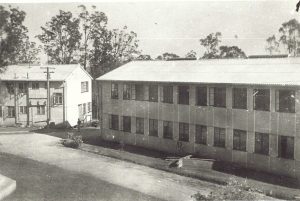
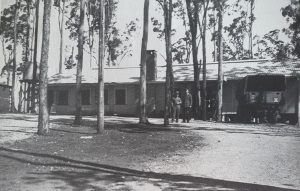
They constructed new office buildings, club facilities and a laundry while showers and toilets were added to the accommodation huts. After taking advice from US authorities, the Australian Government took the unusual step of not charging the Dutch for the lease of the site under a Reciprocal Lend Lease arrangement((In return for Lend Lease aid, Allied nations were to provide goods or services to the United States for their assistance in the war under a program known as reverse or reciprocal lend lease. Similar arrangements were made between other allies such as in this case between Australia and the Netherlands. allowing for the provision of aid between World War II allies with war materials, such as ammunition, tanks, airplanes, and trucks, and with food and other goods.
According to Lockwood (Rupert Lockwood – The Indonesian Exiles in Australia, 1942-47), there was criticisms about the rather luxurious renovation, including beer gardens for the Dutch colonial officers amidst war time austerity. It was thought that the American camp, certainly by Australian military standards was already in an excellent condition. Over the following months the following groups moved to Camp Columbia and some of the other buildings in Brisbane:
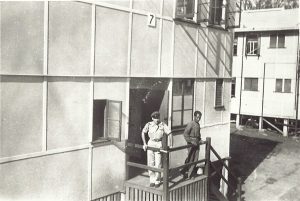
- The seat of the NEI Government-in-Exile was established in the former HQ of the US 6th Army.
- The Headquarters if the NEI Army.
- Specialised Dutch military units moved to Brisbane to serve the NEI government-in-exile.
- The Women’s Army Corps moved to Camp Columbia but trained at Yeronga Park.
- NEFIS, the first unit to move to Camp Columbia, provided one of the most important contributions to the Allied effort. Providing critical intelligence information supporting the war effort. They also leased offices at the New Zealand Insurance Building at 334-338 Queen Street in Brisbane.
- NEI Government Information Service (NEIGIS) along with its Film and Photographic Unit.
- The NEI Army Air Corps (Militaire Luchtvaart or ML-KNIL) leased fourth floor offices in the Courier Building at 240 Queen Street, as headquarters.
- Mornington House Wooloowin housed Dutch aircrew who flew air transport for Camp Columbia.
- By June 1944 there were 16 Dutch Dakota aircraft concentrated at Archerfield aerodrome.
- The NEI government-in-exile continued to rent the Pacific Private Hotel at 421 Brunswick Street, Fortitude Valley for use as a hotel or canteen for Dutch military personnel.
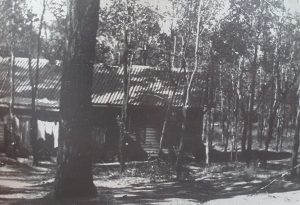
The Netherlands Forces Intelligence Service (NEFIS) was a Dutch military intelligence service during and after World War II. The purpose of the NEFIS was initially to collect intelligence for the Allied forces with regard to the Netherlands East Indies (NEI) that was occupied by Japan. It operated from Melbourne and later from Camp Columbia in Brisbane. NEFIS was eventually given its own clandestine operations unit, dubbed the Korps Insulinde. After the war in Indonesia, back in the Netherlands Korps Insulinde grew into today’s modern Korps Commandotroepen.
Furthermore two small warehouses were allotted to the Dutch at the US supply base of Camp Meeandah at Pinkenba. All sites were chosen for their transport links to Camp Columbia. Archerfield – then Brisbane’s domestic airport – was close to Camp Columbia and Pinkenba, Fortitude Valley and the CBD were connected to Wacol by rail.
Other facilities moved to Camp Columbia too. The Bank voor Nederlandsch Indie NV (NEI Bank Ltd), that controlled the currency supply for the liberated parts of the NEI, was one of the first. The Bank oversaw the NEI government-in-Exile’s new economic agencies. These were:
- The Nederlandsche Indische Escompto Maatschappij NV (NEI Discount Co Ltd);
- The Nederlandsche Indische Handelsbank NV (NEI Commercial Bank Ltd); and
- The Nederlandsche Handel Maatschappij NV (Dutch Trading Company Ltd).
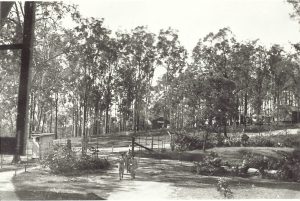
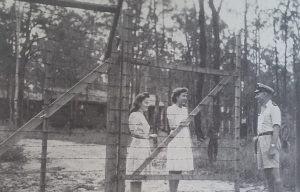
The Netherlands Indies Civil Administration (NICA) headquarters went to Camp Columbia. NICA’s role was to follow behind the Allied invasion of the NEI and restore the Dutch colonial administration in the re-occupied areas. NICA units were militarised; they provided civil relief and rehabilitation plus defended the local population from Japanese raids. They however, where a drain on the military efforts aimed at liberating DNG. All NEI operations suffered from a serious lack of manpower throughout the war. NICA also ran an administration school in Melbourne for new staff needed after the liberation. Their task after the Japanese surrender was horrific with enormous shortages of food, clothing, medicines, etc.
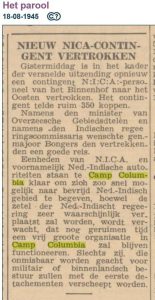
Some of the key activities that took place from their new premises in Camp Columbia:
- Negotiating the acquisition of civil relief supplies with the Australian Government and the United Nations Relief and Rehabilitation Administration (from 1945 onwards).
- Seeking Commonwealth permission for the basing in Australia of a 30,000-strong liberation army being raised in the Netherlands((Originally the Australian Government had committed to base as many of 30,000 Dutch soldiers for training in bases in Western Australia which were already surveyed for this. The Dutch however wanted to increase these numbers to 100,000. However, when the first ship with 1,500 new recruits arrived in Brisbane, they received a hostile reception and the troops couldn’t get ashore. In the end the troops had to go untrained to Java and the plans for Dutch training camps in Australia evaporated.)).
- Signing of the Principles Governing Arrangements for Civil Administration and Jurisdiction in Netherlands Territory in the Southwest Pacific Area agreement with General Douglas MacArthur on 10 December 1944.
-
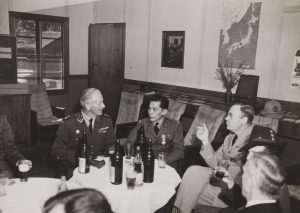
General van Oyen, Mauritz Kokkelink and Governor General van Mook after the medal ceremony at Camp Columbia Supplying members to the Dutch delegation to the UN Plenary Conference held in San Francisco (25 April to 26 June 1945), where the Charter of the United Nations was officially and unanimously adopted by the 50 states present, representing over 80% of the global population.
- On 8 August 1945: Seargent Mauritz Christiaan Kokkelink, of the Royal Netherlands Army, was decorated with the highest military award of his country, the Militaire Willems Orde, at Camp Columbia in front of 500 of the highest-ranking Dutch and Allied service men and women.
The Navy and Air Force headquarters didn’t move to Camp Columbia. The Royal Netherlands Navy was situated at 441 St Kilda Road in Melbourne and the Air Force was a few door further on at 431 St Kilda Road.
There were ongoing small diplomatic raptures in the relationship between the Dutch and Australian authorities, the major issue was the frustration by the Australians that not all people transported by the Dutch from liberated Dutch New Guinea had the required paperwork in place. The Australians were paranoid about their White Australian Policy and didn’t want any coloured people coming in, unless their cases were thoroughly investigated, the bureaucracy around that could take weeks or months and the Dutch took the attitude to bypass the bureaucracy and ask for forgiveness later, this attitude was regarded by the Australians as arrogant. An interesting case involved a Dutch dance group that toured the Allied Forces in the South West Pacific in 1945.
Housing
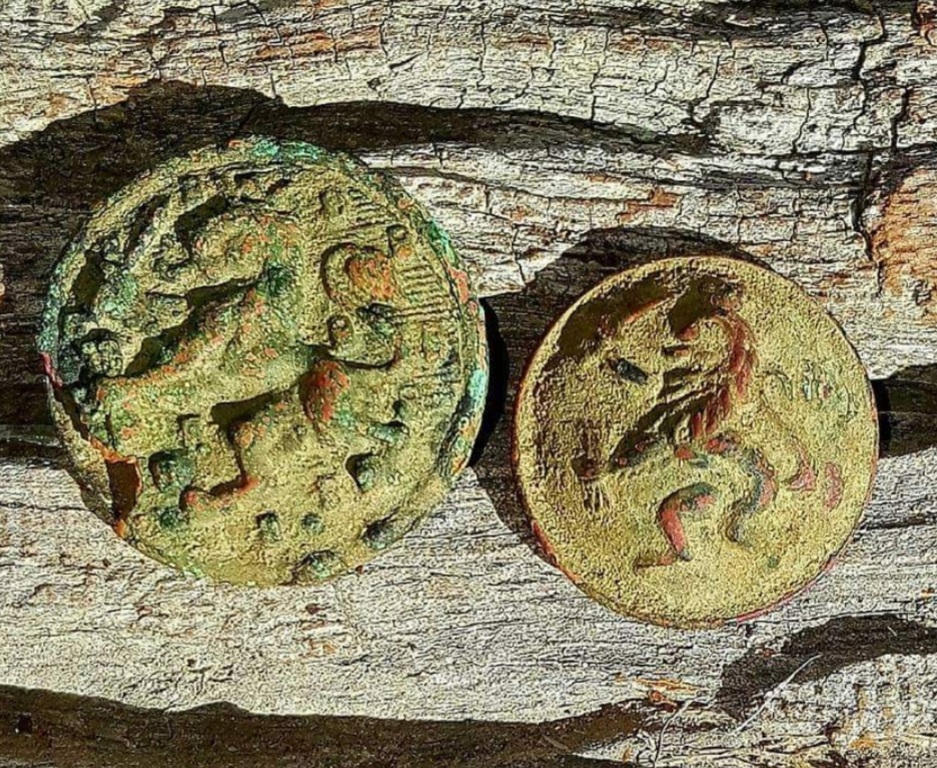
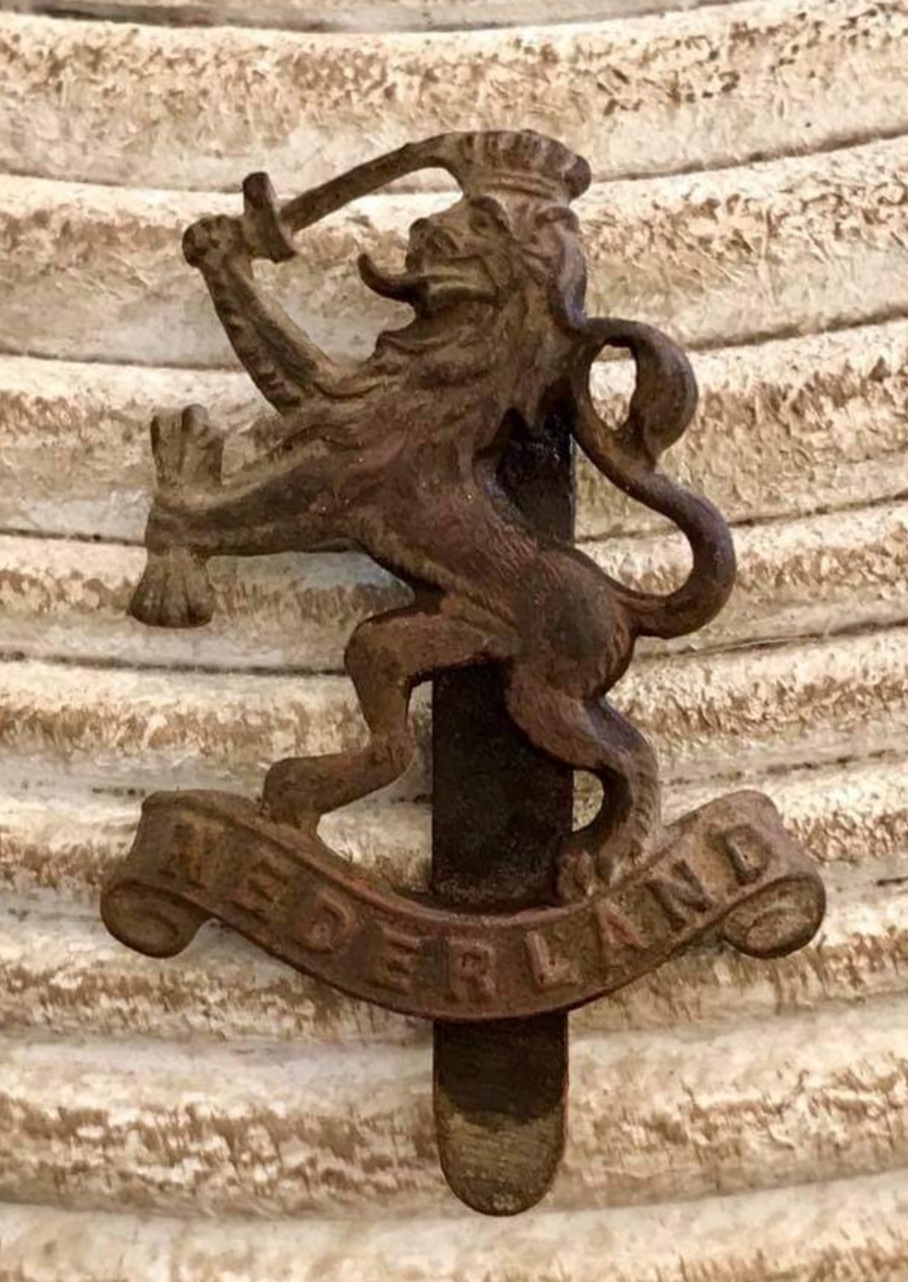
A large number of buildings were built scattered between the headquarters and the hospital. They are both side of the Wacol Station Road. It was in these house, close to Sandy Creek, that a large number of the Dutch staff members were housed. This is also the area where the dog tag of Willy de Eeren was found (see below) as well as other Dutch artifacts, by people using detectors. There are several remnants of buildings in the area on the side of the Wacol Station Road that is now situated in the Pooh Corner Reserve. It is yet unknown what these remnants represent perhaps part of a kitchen, other parts of an ablution pit. The houses here were not connected to the main sewerage facility.
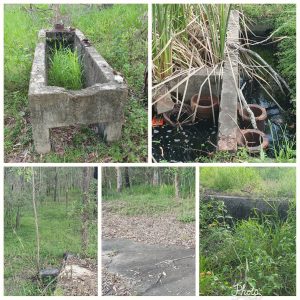
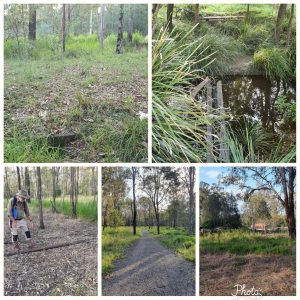
There is also a track (Picture right – top left) that would have been a previous road in this area. A bit further to the north are the ruins of the above mentioned sewerage plant (bottom right). From here the pipes would come down from the headquarter buildings on the top of the hill. Part of the current walking track through the Reserve follows these pipes and some of the pipes, wrapped in concrete is now exposed (2 pics bottom left). There are also the remnant of a bridge over Sandy Creek, used for the sewerage pipes (top right).
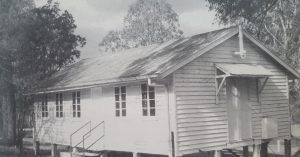
Claire Wilson (nee Evans) recalls in the book World War II stories from Brisbane’s South West by Vicki Mynott:
“In the latter years of the war we got to know some of the Dutch soldiers as they visited our homes for meals, music and relaxation. I have a letter from the family of one in Holland, thanking my aunt Audrey Jones for the parcel of handknitted articles she had made for them”.
